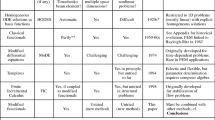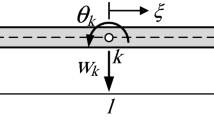Abstract
This paper proposes a new class of shape polynomials, able of solving the well known shear-locking phenomena and the high-order time derivative effect problems which can suffer the Mindlin plate model. These polynomials eliminate the inconsistency of the higher-order spectra because are built on the consistent version of the governing equations previously proposed by Elishakoff. Using these equations, the new class of interdependent shape polynomials is obtained by introducing a new kinematic variable: the fictitious deflection. The interdependence of the polynomials ensures that the corresponding finite element model is free of locking. Lastly, the interdependent shape polynomials for the Timoshenko beam model are derived as a special case.
Similar content being viewed by others
References
Reddy JN (1980) A penalty plate bending element for the analysis of laminated anisotropic composite plates. Int J Numer Methods Eng 15:1187–1206
Averill RC, Reddy JN (1990) On the behavior of plate elements based on the first-order shear deformation theory. Eng Comput 7:57–74
Zienkiewicz OC, Taylor RL, To JM (1971) Reduced integration technique in general analysis of plates and shells. Int J Numer Methods Eng 3:275–290
Hughes TJR, Taylor RL, Kanoknukulchai W (1977) Simple and efficient element for plate bending. Int J Numer Methods Eng 11:1529–1543
Reddy JN (1993) An introduction to the finite element method, 2nd edn. McGraw-Hill, New York
Lee SW, Wong C (1982) Mixed formulation finite elements for Mindlin theory plate bending. Int J Numer Methods Eng 18:1297–1311
Auricchio F, Taylor RL (1995) A triangular thick plate finite element with an exact thin limit. Finite Elem Anal Des 19:57–68
Lovadina C (1998) Analysis of a mixed finite element method for the Reissner–Mindlin plate problems. Comput Methods Appl Mech Eng 163:71–85
Cazzani A, Lovadina C (1997) On some mixed finite element methods for plane membrane problems. Comput Mech 20:560–572
Garusi E, Tralli A, Cazzani A (2004) An unsymmetric stress formulation for Reissner–Mindlin plates: a simple and locking-free rectangular element. Int J Comput Eng Sci 5:589–618
Cazzani A, Garusi E, Tralli A, Atluri SN (2005) A four-node hybrid assumed-strain finite element for laminated composite plates. Comput Mater Contin 2:23–38
Hughes TJR, Tezduyar T (1981) Finite elements based upon Mindlin plate theory with particular reference to the four-node isoparametric element. J Appl Mech 48:587–596
Bathe KJ (1996) Finite element procedures. Prentice-Hall/MIT, Englewood Cliffs
Zienkiewicz OC, Taylor RL (2000) The finite element method, 5th edn. Butterworth-Heinemann, Oxford
Bletzinger K, Bischoff M, Ramm E (2000) A unified approach for shear-locking-free triangular and rectangular shell finite elements. Comput Struct 75:321–334
Nguyen-Xuan H, Liu GR, Thai-Hoang C, Nguyen-Thoi T (2010) An edge-based smoothed finite element method (ES-FEM) with stabilized discrete shear gap technique for analysis of Reissner–Mindlin plates. Comput Methods Appl Mech Eng 199:471–489
Liu GR, Nguyen-Thoi T, Lam YK (2009) An edge-based smoothed finite element method (ES-FEM) for static, free and forced vibration analyses of solids. J Sound Vib 320:1100–1130
Falsone G, Settineri D (2012) A Kirchhoff-like solution for the Mindlin plate model: a new finite element approach. Mech Res Commun 40(1):10
Falsone G, Settineri D (2011) An Euler–Bernoulli-like finite element method for Timoshenko beams. Mech Res Commun 38:12–16
Stephen NG (1982) The second frequency spectrum of Timoshenko beams. J Sound Vib 80:578–582
Stephen NG (2006) The second spectrum of Timoshenko beam theory—further assessment. J Sound Vib 292:372–389
Stephen NG (1997) Mindlin plate theory: best shear coefficient and higher spectra validity. Journal of Sound Vibration 202:539–553
Levinson M (1998) Free vibrations of a simply supported, rectangular plate: an exact elasticity solution. J Sound Vib 98:2898
Elishakoff I (2010) An equation both more consistent and simpler than the Bresse–Timoshenko equation. In: Gilat R, Banks-Sills L (eds) Advances in mathematical modeling and experimental methods for materials and structures, solid mechanics and its applications. Springer, Berlin, pp 249–254
Nesterenko VV (1993) A theory for transverse vibrations of a Timoshenko beam. PMM J Appl Math Mech 57:669–677
Timoshenko SP (1921) On the correction for shear of the differential equation for transverse vibration of prismatic bars. Philos Mag Ser 6(41):744–746
Elishakoff I, Lubliner E (1984) Random vibration of a structure via classical and non classical theories. In: Eggwertz S, Lind NC (eds) Probabilistic methods in the mechanics of solids and structures. Springer, Berlin, pp 455–468
Elishakoff I, Livshits D (1989) Some closed-form solutions in random vibrations of Timoshenko beams. Probab Eng Mech 4:49–54
Sayir M (1980) Flexural vibrations of strongly anisotropic beams. Ingenieur-Archiv 49:309–323
Elishakoff I (1994) Generalization of the Bolotin’s dynamic edge effect method for vibration analysis of Mindlin plates. In: Cuschieri JM, Glegg SAL, Yeager DM (eds) National conference on noise control engineering, New York, pp 911–916
Reddy JN, Wang CM, Lee KH (1997) Relationship between bending solution of classical and shear deformation beam theory. Int J Solids Struct 34(26):3373–3384
Wang CM (1995) Timoshenko beam bending solutions in terms of Euler–Bernoulli solutions. J Eng Mech 121:763–765
Reddy JN (1997) On locking free shear deformable beam elements. Comput Methods Appl Mech Eng 1997(149):113–132
Kaplunov JD, Kossovich LY, Nolde EV (1998) Dynamics of thin walled elastic bodies. Academic Press, San Diego
Averill RC, Reddy JN (1992) An assessment of four-noded plate finite element based on a generalized third-order theory. Int J Numer Meth Eng 33:1553–1572
Hashemi SH, Arsanjani M (2005) Exact characteristic equations for some of classical boundary conditions of vibrating moderately thick rectangular plates. Int J Solids Struct 42:819–853
Author information
Authors and Affiliations
Corresponding author
Appendix
Appendix
A n-nodes FE is taken into account and it is supposed that the vector \( {\bar{\mathbf{u}}} \) collects the nodal values of \( \bar{U} \), of \( - \partial \bar{U}/\partial x \) and of \( - \partial \bar{U}/\partial y \). Likewise, the vector u collects the nodal values of U, \( \varPhi_{x} \) and \( \varPhi_{y} \). If the jth, the j + 1th and the j + 2th element of \( {\bar{\mathbf{u}}} \), (\( \bar{u}_{j} \), \( \bar{u}_{j + 1} \) and \( \bar{u}_{j + 2} \)), are the nodal values of \( \bar{U} \), \( - \partial \bar{U}/\partial x \) and \( - \partial \bar{U}/\partial y \) at the node of coordinates \( \left( {x_{j} ,y_{j} } \right) \), using the relationships given in Eqs. (20) and the approximation for \( \bar{U} \) given in Eq. (21a), the following expressions are obtained:
where u j , u j+1 and u j+2 are the nodal values of U, \( \varPhi_{x} \) and \( \varPhi_{y} \) at the node of coordinates \( \left( {x_{j} ,y_{j} } \right) \). Applying the above equations for all the n nodes of the element, that is for \( j = 1,2, \ldots n \), it is possible to write the following compact equation:
where C is a constant square matrix of order 3n whose kth row is equal to:
-
(a)
the function vector \( - \left( {r_{I} /r_{A} + D/S} \right)\nabla^{2} {\varvec{\uppsi}}^{T} \) evaluated at the corresponding nodal coordinates, if the u k element is a deflection;
-
(b)
the function vector \( - r_{I} /r_{A} \partial \nabla^{2} {\varvec{\uppsi}}^{T} /\partial x \) evaluated at the corresponding nodal coordinates, if the u k element is a rotation \( \varPhi_{x} \);
-
(c)
the function vector \( - r_{I} /r_{A} \partial \nabla^{2} {\varvec{\uppsi}}^{T} /\partial y \) evaluated at the corresponding nodal coordinates, if the u k element is a rotation \( \varPhi_{y} . \)
Equations (23) in the text follow immediately from Eq. (41).
Rights and permissions
About this article
Cite this article
Falsone, G., Settineri, D. & Elishakoff, I. A new class of interdependent shape polynomials for the FE dynamic analysis of Mindlin plate Timoshenko beam. Meccanica 50, 767–780 (2015). https://doi.org/10.1007/s11012-014-0032-9
Received:
Accepted:
Published:
Issue Date:
DOI: https://doi.org/10.1007/s11012-014-0032-9




